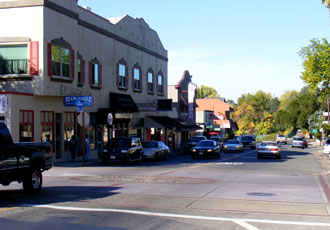Fair Oaks
 The community began as part of the 1844 Rancho San Juan Mexican land grant. In 1895, Brevet Brigadier General Charles Henry Howard and James W. Wilson of the Howard-Wilson Publishing Company of Chicago acquired rights to present Fair Oaks community, then primarily covered by citrus farms, from California Senator Frederick K. Cox and businessman Crawford W. Clarke. The Howard-Wilson company surveyed and mapped the land and began to promote Fair Oaks as one of their “Sunset Colonies.” The Howard-Wilson company advertised Fair Oaks as an innovative and growing citrus colony after destructive freezes in Southern California and Florida and a national depression hitting in 1893. Many of the purchasers were professionals and other friends of the investors and the Fair Oaks community was initially composed primarily of businessmen and other professionals, including bankers and engineers.
The community began as part of the 1844 Rancho San Juan Mexican land grant. In 1895, Brevet Brigadier General Charles Henry Howard and James W. Wilson of the Howard-Wilson Publishing Company of Chicago acquired rights to present Fair Oaks community, then primarily covered by citrus farms, from California Senator Frederick K. Cox and businessman Crawford W. Clarke. The Howard-Wilson company surveyed and mapped the land and began to promote Fair Oaks as one of their “Sunset Colonies.” The Howard-Wilson company advertised Fair Oaks as an innovative and growing citrus colony after destructive freezes in Southern California and Florida and a national depression hitting in 1893. Many of the purchasers were professionals and other friends of the investors and the Fair Oaks community was initially composed primarily of businessmen and other professionals, including bankers and engineers.
A club of businessmen in Chicago and Sacramento who had an investment (land or fruit) in the newborn colony and Orangevale formed the Chicago-Fair Oaks Club in 1899. Then a group of local businessmen, including Valentine S. McClatchy (the co-owner of the Sacramento Bee), incorporated the Fair Oaks Development Company in 1900. The boosters proclaimed Fair Oaks to be the “crown of the [Sacramento] valley,” in the “heart of California.”
Together these groups were able to succeed in constructing an efficient water supply. They convinced the Sacramento Chamber of Commerce, which McClatchy’s business partners from Orangevale created and chaired, to build a bridge across the American River at Fair Oaks in 1901. At the same time, the community leaders were also able to persuade the Southern Pacific Rail Road Company to build a railroad line to the bridge.
20th century and growth
Fair Oaks grew rapidly with the completion of the Fair Oaks Bridge and the railroad line. The Fair Oaks Fruit Company incorporated in 1902 and built a warehouse in Fair Oaks to export not only citrus, but also almonds and olives. Also, in 1902, Dr. R. N. Bramhall became the first medical doctor to reside and set up office in Fair Oaks. The agricultural productivity attracted the development of other community services. Fair Oaks had become a typical small town by 1906 with a post office, hotel, blacksmith shop, lumber yard, pharmacy, bank, cemetery, newspaper, and a number of small dry-goods and grocery stores located along Main Street.
Two churches (Methodist and Presbyterian) were built and two schools (The Four Gables School and the Fair Oaks School—the current Community Clubhouse) appeared by 1910. The Fair Oaks Library Association formed in 1908 and constructed a permanent building in 1912. The Fair Oaks Civic Club purchased and developed the Plaza in 1918 for recreational and leisure activities. This plaza is still in use today.
No longer citrus
A big freeze hit in 1932 at the height of the Great Depression and many or most citrus groves were lost. After this and a similar freeze in 1934, Fair Oaks was no longer a major producer of citrus fruit in California. Fortunately, growth of the defense firm Aerojet helped the Fair Oaks economy offset the demise of its primary industry. Some temporary dislocations occurred when employment at Aerojet dropped over 90% in the late 1960s and early 1970s. The growth rate still continued, however, because of the increased access to Sacramento by Highway 50 and the construction of the Sunrise Boulevard Bridge in 1954. This allowed for both residents of Fair Oaks to find greater employment in the connecting area and for Sacramentans to relocate to Fair Oaks more easily. The former citrus colony transformed into a bedroom community of greater Sacramento.
Population Data
| City Population | 30,912 |
| Urban Area Population | 1.393 Million |
| Metro Area Population | 2.176 Million |
Demographics
| Race | White 85.8% | Asian 8.5% |
| Hispanic Origin | 10.3% |
| U.S. Citizen | 94.3% |
Education
| College Degree or Higher | 52.4% |
| High School Diploma | 16.7% |
| Less Than High School | 5.9% |
Income Data
| Median Household Income | $73,616 |
| Per Capita Income | $40,061 |
| Below Poverty Line | 8.8% |
Economic Data
| Median Home Price | $239,500 |
| Unemployment Rate | 7.1% |
| Sales Tax Rate | 8% |
Boundary Maps

